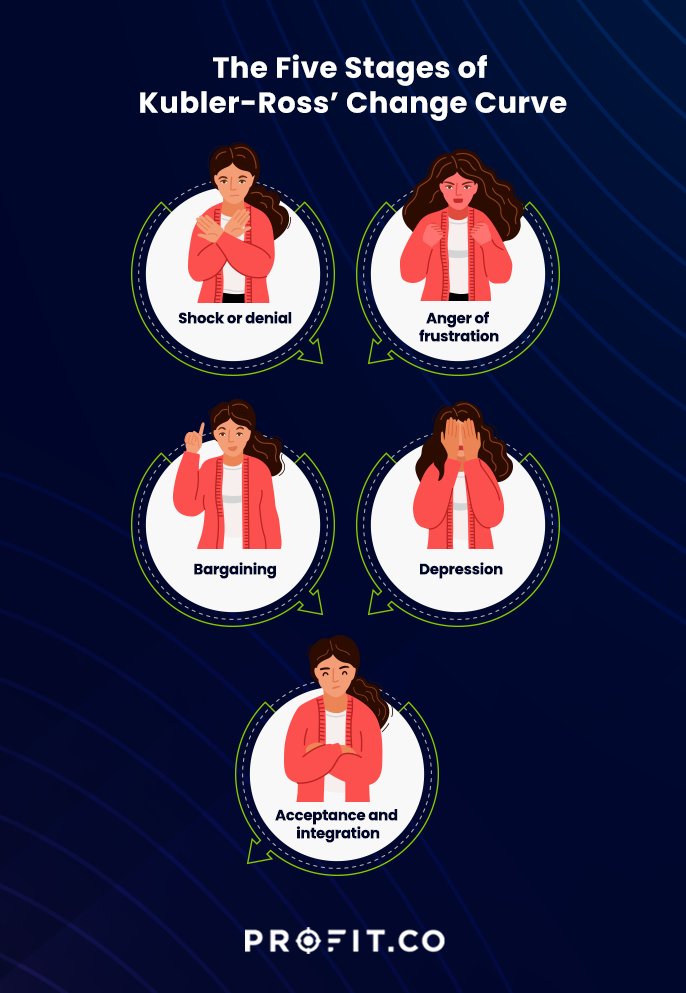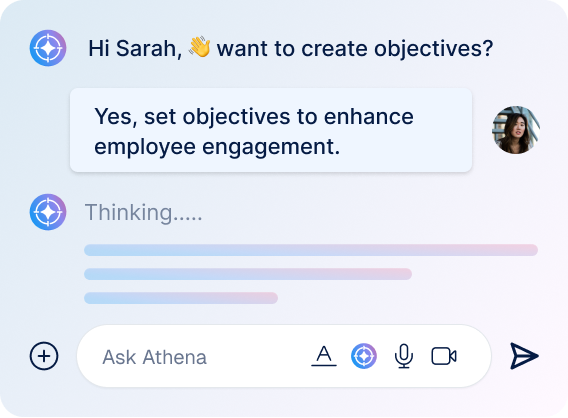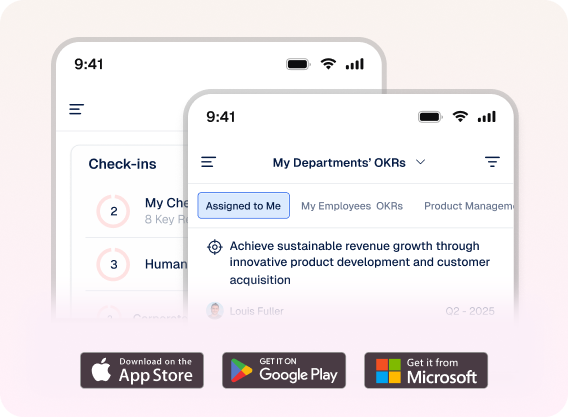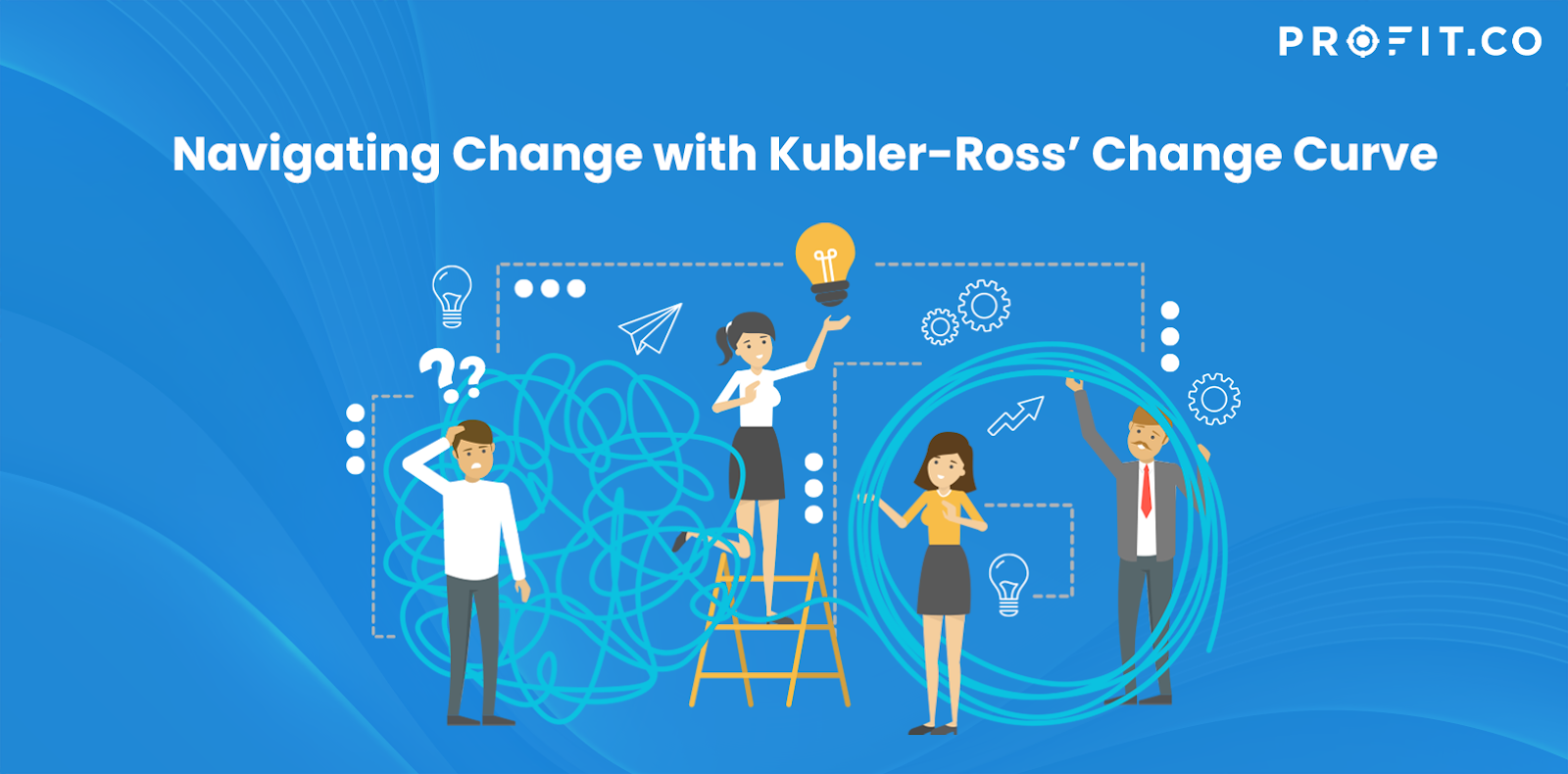The Kubler-Ross Model, more popularly known as the “five stages of grief,” was established and introduced by Swiss-American psychiatrist Elisabeth Kübler-Ross. Her 1969 book “On Death and Dying” first mentioned it. Terminally ill patients inspired the book, and Kübler-Ross posited that there are five phases to grief that humans universally go through.
Although it was made primarily to understand grieving people’s behavior, this model is now being used to understand the behavior of people undergoing organizational change. This is because, at its core, grieving is all about change.
Let’s dive into the model and how it applies to organizational change.
Five Stages of Kubler-Ross’ Change Curve
Kubler-Ross’ Change Curve is a behavioral approach to organizational change. It is based on the premise that the entire organization will go through the five stages of grief when transitioning. These stages commonly associated with grief are also normal reactions when changing whatever aspect of a person’s life.
The goal is to understand the organization’s members’ behavior and how leaders can cope, help, and address these feelings throughout the organizational change process.

Stage 1: Shock or denial
When people in the organization face impending change, usually, the first defense mechanism of people is to deny that it will happen. While it is pretty frustrating if you are the leader implementing the change, it is essential to remember that this is temporary.
The normal behavior of denial regarding organizational change includes rejecting the thought of the impending transition, confirmation bias, low energy, and mood. This translates to subpar performance, thinking the change will not push through, no empathy for the transition, and believing that the change is unnecessary. They might also avoid talking about the impending transition altogether.
To address this, leaders should communicate that the change is real and happening and give enough time for the news to settle in. Don’t rush into implementing the change as much as possible to give members the time to go through this phase overcome and digest it.
Start your Change Management journey today with Profit.co
Stage 2: Anger or frustration
After realizing that the impending change is real and that it will happen, people go into the anger stage. It is the part where they will look for people or events to blame to associate their anger with. They might be angry with the boss, the leader, the person who suggested the change, their colleagues, or sometimes with themselves. Leaders must look out for self serving bias among stakeholders that can lead to resistance for change.
Normal behavior during this stage of change includes:
- a high level of frustration in the atmosphere
- trying to pick fights
- opening heated discussions
- blaming other people
- blaming the team
- blaming the company
- recounting where things might have gone wrong
- the anxiety of things to come
- general irritation every time the topic is brought up
To address this, leaders should be level-headed in dealing with frustrated members and aware that this is temporary too, and will likely pass. However, level-headedness does not mean being deaf to their grievances. Leaders should always listen to what members say and acknowledge their emotions and feelings are valid.
Stage 3: Bargaining
This stage attempts to delay the inevitable. In the bargaining stage, people try to find a middle ground between what is and what is to come. The natural reaction is that if the change is inevitable, maybe going halfway through the journey may not be as bad as doing it all. That is why they bargain. It is also an escapist behavior and a last-ditch effort to avoid what will happen.
In this environment, members will likely change their work style, thinking the change will no longer be necessary if they deliver more. They will also probably talk to the person in charge and persuade them to change the transition’s implementation plan to a more watered-down one.
To address this, leaders must be firm in their decision and stick to their prepared implementation plan. A strong leader knows when to listen to the members’ grievances and when to be firm in the decision. It is crucial to understand how to distinguish between the two for the success of the transition. Aside from that, leaders should also assure their members during this stage to reduce their anxieties.
The five stages – denial, anger, bargaining, depression, and acceptance – are a part of the framework that makes up our learning to live with the one we lost. They are tools to help us frame and identify what we may be feeling. But they are not stops on some linear timeline in grief.
Stage 4: Depression
It is the initial stage where you can see the changes manifesting within the organization. However, they will not be happy about it. In this stage, they start to embrace the change but are likely focused on all the losses rather than the gains of the change.
This stage’s hallmark behavior includes having very low energy in tasks, a general vibe of demotivation across the organization, and members feeling overwhelmed about what they have to do and what they have to take in. Some may feel helpless and sad.
To address this, leaders should empathize with their members and accept that this is not easy for most. Giving them space to feel this is essential because it is a necessary step for acceptance. Forcing them out of this stage will only lead to resentment and anger. Leaders can offer internal support during this time, such as training, resources, and general words of wisdom. They can also remind people of the long-term benefits of making the change.
Stage 5: Acceptance and integration
It is the final stage in the journey of change. Despite the roller coaster of emotions, people eventually accept the transition wholeheartedly and integrate themselves as they find their place in the new environment.
You will know when your organization is in this phase when you see behavior shifts like:
- higher engagement with the new situation
- initiating learning
- having a more optimistic outlook on the long-term effects of the change
- recognizing the benefits of the transition
- fully integrating within the new system
While this is an excellent stage, leaders still have to play an active role in this phase to ensure the long-term change will be sustained. Among the crucial things that a leader can do is gather feedback from the entire experience, distinguish pain points and solve them, project potential threats and learn how they can be prevented, track progress, show appreciation to the team, and celebrate small wins.
How Does Kubler-Ross’ Change Curve Help Organizations?
This model benefits significant changes that might be emotionally charged in the organization. Examples of scenarios include:
- a change in the location of the office
- a shift from the office-based working environment to work-from-home
- drastic cost-cutting
- reshuffling of personnel to various organizations, dissolving a department, etc.
With these kinds of changes, skills and technicality should take a backseat, and the emotions and behaviors of the organization members should be a priority.
How Can OKRs Make the Change Process More Effective?
Kubler- Ross Change Management Model can provide a valuable framework for managing the change process. The OKR methodology can be used to set specific goals for the change and define the key results to indicate progress toward those goals. This goal-setting framework ensures that the organization is focused on achieving specific outcomes related to the change and can measure progress toward those outcomes. The two frameworks provide a structured approach to change management that can minimize disruption and ensure the transition is implemented smoothly and effectively.
FAQs
- What are the five stages of Kubler-Ross’ Change Curve?
The five stages of Kubler-Ross’ Change Curve are shock or denial, anger or frustration, bargaining, depression and acceptance, and integration.
- What is unique about Kubler-Ross’ Change Curve?
Kubler-Ross’ Change Curve emphasizes the emotions that occur during change instead of just procedural changes.
- How can leaders support their employees during change?
Leaders should validate the feelings of their employees and encourage them to process however they need. Kubler-Ross’ Change Curve explains that grieving a change is not linear, and leaders should accept an uncertain timeline. However, they should also be firm in their implementation plan.
Conclusion
Kubler-Ross’ Change Curve gives space for the emotional journey change entails. Organizations need to establish a structure for change management and consider the employees and their reactions to change. The five stages and their challenges are inevitable; having the forefront knowledge prepares teams to adapt. Implementing change is difficult but worthwhile to allow your team and organization to thrive.




